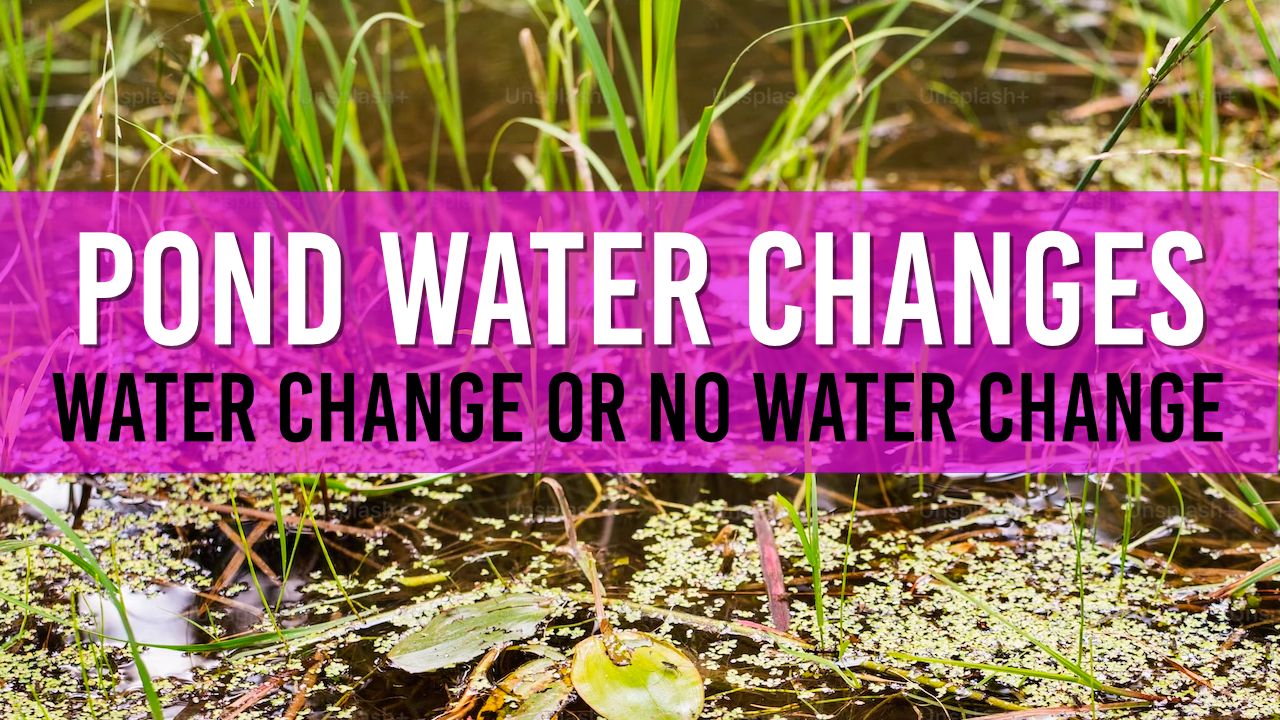Do Garden Ponds Need Water Changes?
In short, Yes - A new unestablished pond will require water changes. However, with the right filtration water changes can be less frequent providing you are checking the quality of your pond water.

Table of Contents
Hey there, fellow pond enthusiasts! Are you ready to dive into the fascinating world of garden pond maintenance? In this comprehensive guide, I'll explore the ins and outs of water changes and why they're so essential for a thriving pond ecosystem.
With easy-to-follow instructions, practical tips, and answers to your most pressing questions, this article is your go-to resource for creating and maintaining the garden pond of your dreams.
So, let's get started and unlock the secrets of a healthy, beautiful pond together!
Why are Water Changes Necessary in Garden Ponds?
Water changes play a crucial role in maintaining the health of a garden pond. They help to:
- Remove excess nutrients, such as nitrates and phosphates, which can lead to algae blooms and poor water quality.
- Eliminate harmful chemicals and toxins that can build up over time and harm your pond's inhabitants.
- Maintain stable water parameters, such as pH, hardness, and alkalinity, which are essential for the health of fish and plants.
Failing to change the water in your garden pond can result in poor water quality, unhealthy fish, and unattractive algae growth.
How Often Should You Change the Water in Your Garden Pond?
The frequency of water changes in a garden pond depends on various factors, including:
- The size of the pond
- The number of fish and plants
- The type of filtration system
As a general guideline, aim to change 10-20% of the water in your pond every two to four weeks. However, this may vary depending on the specific conditions of your pond. It's essential to monitor water quality regularly and adjust your water change schedule accordingly.
How to Change the Water in Your Garden Pond
Follow these steps to safely and effectively change the water in your garden pond:
- Gather necessary tools and equipment, such as a pond pump, hose, and buckets.
- Turn off any pond equipment, such as filters and water features.
- Use a pond pump or hose to remove the desired amount of water from the pond. Be sure to avoid removing too much water, as this can stress fish and plants.
- Refill the pond with fresh, dechlorinated water. It's essential to match the temperature and water parameters of the new water to the existing pond water to avoid shocking the pond's inhabitants.
- Turn the pond equipment back on and monitor the water quality for any changes.
Alternative Methods to Water Changes
Aside from water changes, there are alternative methods to help maintain a healthy garden pond:
- Beneficial bacteria: Adding beneficial bacteria can help break down harmful waste products and improve water quality.
- Natural water treatments: Products such as barley straw and water clarifiers can help reduce algae growth and improve water clarity.
Each alternative method has its pros and cons, so consider your specific pond requirements when choosing the best option for you.
Frequently Asked Questions
In this section, I'll be answering some of the most common questions related to garden pond maintenance and water changes. My goal is to help you, as a pond owner, better understand how to care for your pond and maintain a healthy, thriving ecosystem.
So, let's dive into these frequently asked questions to discover valuable insights and practical tips that will enhance your garden pond experience.
Can I use tap water to refill my garden pond?
Yes, you can use tap water to refill your garden pond. However, it's essential to treat the water with a dechlorinator before adding it to the pond, as chlorine and chloramine found in tap water can be harmful to fish and plants.
What should I do if I accidentally add too much dechlorinator or water treatment to my garden pond?
If you accidentally add too much dechlorinator or water treatment to your pond, perform an immediate water change to dilute the concentration of the chemicals. Monitor your pond's water parameters and the health of your fish and plants closely for any signs of stress or adverse reactions. If you are unsure about how to proceed, consult a pond expert or a specialist for guidance.
How do I choose the right dechlorinator for my garden pond?
When selecting a dechlorinator for your garden pond, consider the following factors:
- The size of your pond and the volume of water that needs to be treated
- The product's effectiveness at removing both chlorine and chloramine
- The ease of use and application method (e.g., liquid, powder, or tablet form)
Always follow the manufacturer's instructions for proper dosage and application.
How do I know if my pond needs a water change?
Regular water testing is the best way to determine if your pond needs a water change. Test for parameters such as ammonia, nitrite, nitrate, pH, and hardness. High levels of ammonia, nitrite, or nitrate, or significant fluctuations in pH or hardness, indicate that it's time for a water change.
Can I perform a water change when it's raining or during extreme weather conditions?
It's best to avoid performing water changes during heavy rain or extreme weather conditions, as this can affect water quality and temperature. Wait for stable weather conditions before proceeding with a water change.
Can I overdo water changes in my garden pond?
While regular water changes are essential for maintaining a healthy pond, overdoing water changes can stress fish and plants. Aim to change only 10-20% of the water at a time, and avoid changing water too frequently.
How can I reduce the frequency of water changes in my garden pond?
To minimize the need for water changes, consider implementing these best practices:
- Use a high-quality pond filter to remove waste and maintain water quality.
- Avoid overstocking your pond with fish, as this can lead to increased waste and nutrient levels.
- Remove decaying plant matter and debris regularly.
- Feed fish appropriately and avoid overfeeding.
- Consider using natural water treatments or beneficial bacteria to supplement your water change routine.
Can I use water from a natural source, like a river or stream, to refill my garden pond?
While using water from a natural source may seem like a good idea, it can introduce unwanted elements, such as parasites, bacteria, or pollutants, into your pond.
What is the best way to collect and store rainwater for use in my garden pond?
Rainwater collection systems, such as rain barrels or cisterns, can be an excellent method for gathering water for your garden pond. Ensure that the collection system is covered to prevent debris, insects, or other contaminants from entering the stored water.
Should I remove my fish during a water change?
In most cases, it is not necessary to remove fish during a water change. As long as you are only changing 10-20% of the water and maintaining consistent water temperature and parameters, your fish should not experience undue stress. However, if you need to perform a more extensive water change or pond cleaning, consider temporarily relocating your fish to a separate holding tank.
Can I use pond water for my plants and garden?
Yes, pond water can be an excellent source of nutrients for your plants and garden. When performing a water change, consider using the removed water to water your plants, as it is rich in beneficial nutrients and microorganisms. This practice also helps conserve water and reduce waste.
Summary - Do you need to change the water in your Pond?
Yes, you should perform water changes on your pond. The frequency at which you perform this maintenance will be decided by the level of filtration in your pond and the overall health of your water.
If you're noticing that your pond water has started to smell, become very dirty or even your fish are acting quite strange - then perform a small 20% change of water.
As mentioned earlier, many filters have a self-clean option which will not only clean your filter sponges, but will also route the dirty water away from your pond (perfect for shrubs and borders).
If you have any questions - please let me know in the comments below.

